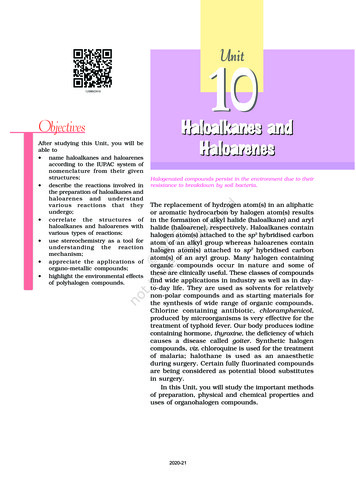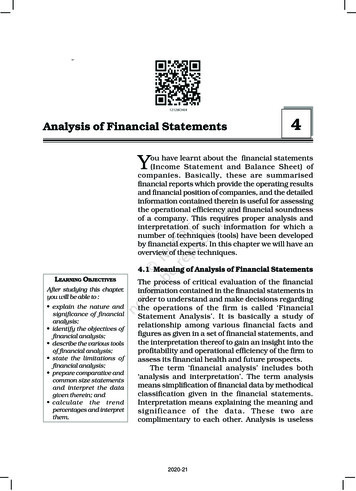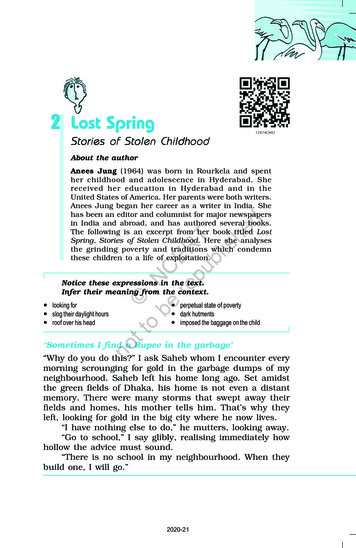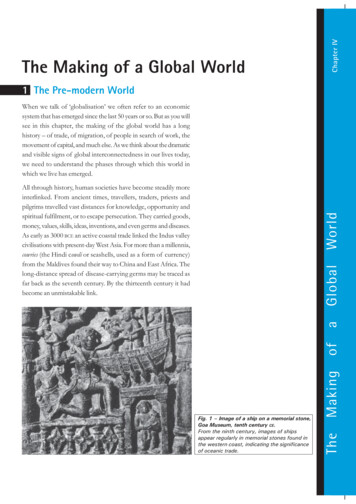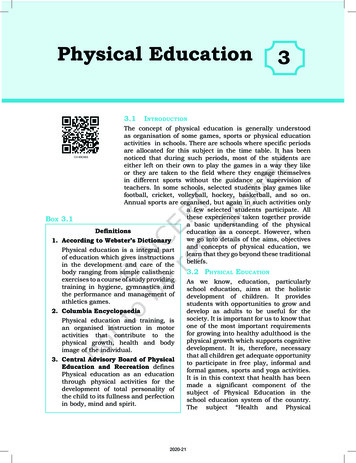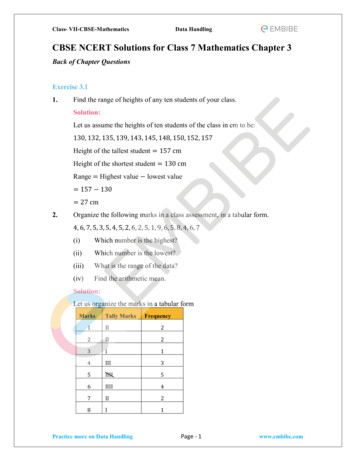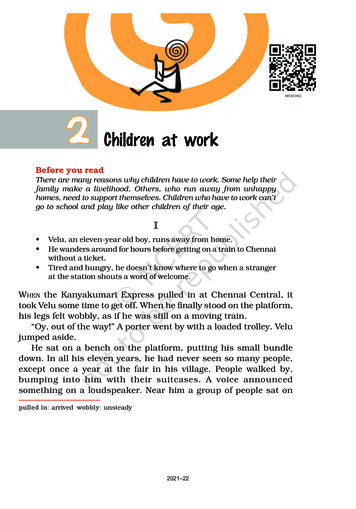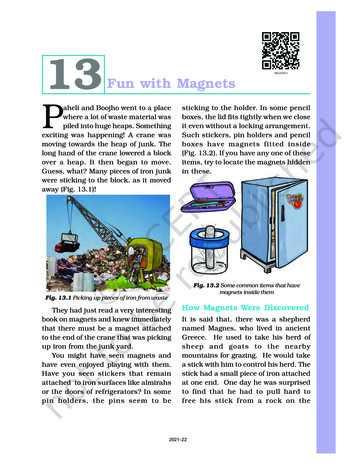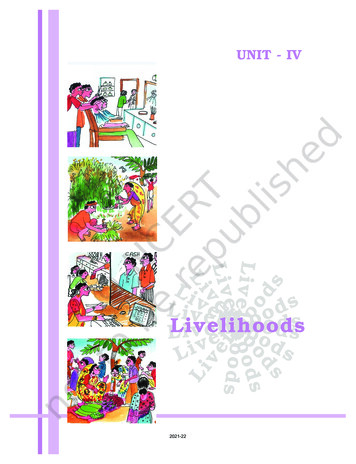
Transcription
UNIT - IVsdsLoooo d sivelie l ih o o d sL i vv e lLiLivelihoodLivsdL i v eell ioohshdoooLivelihoodsohhildeoiLiv el o sdsviL2021-22
2021-22
Chapter 8RuralLivelihoodsIn the first chapter we looked at the many kinds ofdiversity in our lives. We also explored how living indifferent regions has an effect on the work people do,the kinds of plants, trees, crops or things that becomeimportant to them. In this chapter we will look at thedifferent ways in which people earn their living invillages. And here too, as in the first two chapters,we will examine whether people have equalopportunities to earn a living. We will look at thesimilarities in their life situations and the problemsthat they face.1. Describe the work that you see people doing in the abovepictures.2. Identify the different types of work that are related to farmingand those that are not. List these in a table.3. In your notebook draw some pictures of work that you haveseen people do in rural areas and write a few sentences thatdescribe the work.2021-22
68 / Social and Political LifeKalpattu villageKalpattu is a village that's close tothe sea coast in Tamil Nadu.People here do many kinds of work.As in other villages, here too there isnon-farm work such as makingbaskets, utensils, pots, bricks,bullock-carts etc.There are people who provideservices such as blacksmiths, nurses,teachers,washermen,weavers,barbers, cycle repair mechanics andso on. There are also someshopkeepers and traders. In the mainstreet, which looks like a bazaar, youmorning and snacks like vadai, bondaand mysorepak in the evening. Nearthe teashops in a corner lives ablacksmith family whose home servesas their workshop. Next to their homeis a cycle hire and repair shop. Twofamilies earn a living by washingclothes. There are some people who goto the nearby town to work asconstruction workers and lorrydrivers.The village is surrounded by lowhills. Paddy is the main crop that isgrown in irrigated lands. Most of thefamilies earn a living throughagriculture.There are somecoconut groves around.Cotton, sugar cane andplantainarealsogrown, and there aremango orchards. Letus now meet somepeople who work in thefields in Kalpattu andsee what we can learnabout farming fromthem.ThulasiTransplanting paddy is back-breaking work.will find a variety of small shops suchas tea shops, grocery shops, barbershops, a cloth shop, a tailor and twofertiliser and seed shops. There arefour teashops, which sell tiffin – suchas idli, dosai and upama in theAll of us here work onRamalingam'sland.He has twenty acresof paddy fields inKalpattu. Even before I was married Iused to work on paddy fields in myparental village. I work from 8.30 inthe morning till 4.30 in the evening andKaruthamma, Ramalingam's wife,supervises us.2021-22
/ 69the farm he finds work outside, eitherloading sand from the river or stonefrom the quarry nearby. This is sent bytruck to be used in nearby towns tomake houses.Rural LivelihoodsThis is one of the few times in theyear that I find regular work. Now Iam transplanting the paddy, when theplants have grown a bit Ramalingamwill call us again for weeding and thenfinally once again for the harvesting.When I was young I could do thiswork with no difficulty. But now as Igrow older I find bending for longhours with my feet in water verypainful. Ramalingam pays Rs 40 perday. This is a little less than whatlabourers get in my home village, but Icome here because I can depend onhim to call me whenever there is work.Unlike others, he does not go lookingfor cheaper labour from other villages.Our school-going daughters are thejoy of our lives. Last year, one of themfell ill and had to be taken to thehospital in town. We had to sell ourcow to pay back the money weborrowed from Ramalingam for hertreatment.vemyarnuNoJaDecemberMy husband, Raman is also alabourer. We don't own any land.During this time of the year he sprayspesticides. When there is no work onApart from working on the land, I doall the tasks at home. I cook food for myfamily, clean the house and washclothes. I go with other women to thenearby forest to collect firewood. Aboutone kilometre away we have a villageborewell from where I fetch water. Myhusband helps in getting materialssuch as groceries for the JultusyBased on the above diagram wouldyou say that Thulasi earns moneythroughout the year?2021-221. Describe the work thatThulasi does. How is itdifferent from the workRaman does?2. Thulasi gets paid very littlemoney for the work shedoes. Why do you thinkagricultural labourers likeher are forced to accept lowwages?3. In what ways would her wayof earning a living havebeen different if Thulasiowned some farm land?Discuss.4. What are the crops grown inyour region or nearbyrural area? What kindsof work do agriculturallabourers do?
70 / Social and Political LifeAs you saw in Thulasi's story poorfamilies in rural areas often spend alot of time every day collectingfirewood, getting water and grazingtheir cattle.Even though they do not earn anymoney from these activities they haveto do them for the household. Thefamily needs to spend time doing thisas they are not able to survive on thelittle money they earn.Nearly two-fifth of all rural familiesare agricultural labourers in ourcountry. There are some who havesmall plots of land while others likeThulasi are landless.Not being able to earn moneythroughout the year forces people inmany rural areas to travel longdistances in search of work. Thistravel, or migration, takes placeduring particular seasons.Sekarharvesting our field. We don't ownmuch land, only two acres. We manageto do all the work on our own. Attimes, especially during the harvest Itake the help of other small farmersand in turn help them harvest theirfield.The trader gave me seeds andfertilisers as a loan. To pay back thisloan I have to sell my paddy to him ata somewhat lower price than what Iwould get in the market. He has senthis agent to remind farmers who havetaken loans that they will sell thepaddy only to him.I will probably get 60 bags of paddyfrom my field. Some of this I will sell tosettle the loan. The rest will be used inmy home. But whatever I have will lastonly eight months. So I need to earnsome money. I work in Ramalingam'srice mill. Here I help him collect paddyfrom other farmers in the neighbouringvillages.We have to carry this paddy to ourhouse. My family has just finishedWe also have a hybrid cow, whosemilk we sell in the local milkcooperative. This way we get a littleextra money for our everyday needs.On being in DebtAs you've read above, very oftenfarmers like Sekar need to borrowmoney to purchase basic things likeseeds, fertilisers and pesticides. Oftenthey borrow this money frommoneylenders. If the seeds are not ofgood quality or pests attack their cropthere can be a major crop failure.2021-22
Rural Livelihoods/ 71The crops can also be ruinedif the monsoon does not bringenoughrain.Whenthishappens farmers sometimes areunable to pay back their loans.And, for the family to survive,they may even have to borrowmore money. Soon the loanbecomes so large that no matterwhat they earn, they are unableto repay.This is when we can say theyare caught in debt. In recentyears this has become a majorcause of distress among farmers.In some areas this has alsoresulted in many farmerscommitting suicide.Transplanted paddy growing in a few ofRamalingam’s 20 acres. A result of hard labourperformed by agricultural workers like Thulasi.1. What work does Sekar’s familydo? Why do you think Sekar doesnot usually employ labourers fordoing farming work?2. Why does Sekar not go to thetown market to get a better price forhis paddy?3. Sekar’s sister Mina had alsotaken a loan from the trader. Shedoes not want to sell her paddy tohim but she will pay back her loan.Write an imaginary conversationbetween Mina and the trader'sagent and the arguments given byeach person.4. What are the similarities anddifferences between Sekar’s andThulasi’s lives? Your answer couldbe based on the land that theyhave, their need to work on the landthat belongs to others, or loans thatthey need and their earnings.Ramalingam and KaruthammaIn addition to land, Ramalingam’sfamily owns a rice mill and a shopselling seeds, pesticides etc. For therice mill they used some of their ownmoney and also borrowed from thegovernment bank. They buy paddyfrom within the village and fromsurrounding villages. The rice that isproduced in the mill is sold to tradersin nearby towns. This gives them asubstantial income.Read again Sekar’s and Thulasi’saccounts. What do they say aboutRamalingam, the large farmer?Together with what you have readfill in the details below:1. How much land does he have?2. What does Ramalingam do withthe paddy grown on his land?3. Apart from farming how else doeshe earn?2021-22
72 / Social and Political LifeAgricultural Labourers and Farmersin IndiaTerrace Farming in NagalandThis is a village called Chizamiwhich is in Phek district inNagaland. The people of thisvillage belong to the Chakhesangcommunity. They do 'terrace'cultivation.This means that the land on a hillslope is made into flat plots andcarved out in steps. The sides ofeach plot are raised in order toretain water. This allows water tostand in the field, which is bestfor rice cultivation.The people of Chizami have theirown individual fields. But, theyalso work collectively in eachother's fields. They form groupsof six or eight and take an entiremountainside to clean the weedson it.Each group eats together oncetheir work for the day is over. Thisgoes on for several days until thework is completed.In Kalpattu village there areagricultural labourers like Thulasi,and many small farmers like Sekar,and a few big farmers likeRamalingam. In India nearly two outof every five rural families areagricultural labourer families. All ofthem depend on the work they do onother people's fields to earn a living.Many of them are landless and othersmay own very small plots of land.In the case of small farmers likeSekhar their land is barely enough tomeet their needs. In India 80 per centof farmers belong to this group. Only20 per cent of India's farmers are likeRamalingam. These large farmerscultivate most of the land in thevillages. A large part of their produce issold in the market. Many of them havestarted other businesses such asshops, moneylending, trading, smallfactories etc.From the figures given abovewould you say that a majority ofthe country's farmers are quitepoor? What do you think can bedone to change this situation?We have looked at farming inKalpattu. Apart from farming, manypeople in rural areas depend uponcollection from the forest, animalhusbandry, dairy produce, fishing etc.For example, in some villages in2021-22
Rural Livelihoods/ 73central India, both farmingand collection from g mahua, tenduleaves, honey, to be sold totraders, is an importantsourceofadditionalincome.Similarly selling milk tothe village cooperativesociety or taking milk to thenearby town may be themain source of livelihood forsome families.In thecoastal areas, we find fishing villages.Let us find out more about the lives ofa fishing family by reading about Arunaand Paarivelan who live in Pudupet, avillage close to Kalpattu.Aruna and PaarivelanNot very far from Kalpattu is thevillage of Pudupet. People here earntheir living by fishing. Their housesare close to the sea and one finds rowsof catamarans and nets lyingFisher-woman selling the catch at the local market.around. At about 7 o’clockin the morning there is alot of activity on the beach.This is the time when thecatamarans return withtheir catch and womengather to buy and sell fish.My husband Paarivelan,my brother and my brotherin-law returned late today.I was very worried. Theygo to the sea together inour catamaran. They saidthey were caught in astorm. I have kept asidesome fish for the family. I2021-22
74 / Social and Political Lifewill auction the rest. The money I getfrom the auction will be divided intofour shares. One each for each personwho went fishing and the fourth one isfor the equipment. Since we own thecatamaran, engine and nets, we getthat share too. We have taken a loanfrom a bank and purchased an engine,which is fixed on to the catamaran.Now they can go far into the sea sothat they can get a better catch.The women who buy fish here willcarry them in baskets to be sold innearby villages. Then there are otherslike traders who buy for the shops inthe town. I'll only finish this auction bynoon. In the evening my husband andour relatives will untangle and repairour nets. Early tomorrow morningaround 2 a.m. they will set out to seaagain. Every year, for at least aboutfour months during the monsoon, theycannot go to the sea because this iswhen the fish breed. During thesemonths we survive by borrowing fromthe trader. Because of this, later on weare forced to sell the fish to that trader,and cannot do our auction. Those leanmonths are the most difficult. Last yearwe suffered a lot because of thetsunami.Rural LivelihoodsPeople in rural areas earn their livingin various ways. Some work on farmswhile others earn their living on nonfarm activities. Working on farmsinvolves operations such as preparingthe land, sowing, weeding and1. Why do both Sekar's andAruna's families have to borrow?What similarities and differencesdo you find?2. Have you heard of tsunami?What is this and what damage doyou think it might have done tothe life of fishing families likeAruna's?harvesting of crops. We depend onnature for the growth of these crops.Hence life revolves around certainseasons. People are busy duringsowing and harvesting and less so atother times. Rural people in differentregions of the country grow differentcrops. However, we do find similaritiesin their life situations and in theproblems that they face.How people are able to survive orearn will depend upon the land thatthey cultivate. Many depend on theselands for work as labourers. Mostfarmers grow crops both for their ownrequirements and also to sell in themarket. Some have to sell to tradersfrom whom they have borrowedmoney. For their survival, manyfamilies need to borrow money fortheir work or when no work isavailable. There are some families inrural areas which thrive on large acresof lands, business and other bourers,fishingfamilies, crafts persons in the villagesdo not find enough work to keep thememployed throughout the year.2021-22
Rural LivelihoodsQUESTIONS1. You have probably noticed that people in Kalpattu are engaged in avariety of non-farm work. List five of these.2. List the different types of people you read about in Kalpattu whodepend on farming. Who is the poorest among them and why?3. Imagine you are a member of a fishing family and you are discussingwhether to take a loan from the bank for an engine. What would yousay?4. Poor rural labourers like Thulasi often do not have access to goodmedical facilities, good schools, and other resources. You have readabout inequality in the first unit of this text. The difference betweenher and Ramalingam is one of inequality. Do you think this is a fairsituation? What do you think can be done? Discuss in class.5. What do you think the government can do to help farmers like Sekarwhen they get into debt? Discuss.6. Compare the situation of Sekar and Ramalingam by filling out thefollowing edSelling ofharvestOther workdone by them2021-22RAMALINGAM/ 75
1. What work does Sekar’s family do? Why do you think Sekar does not usually employ labourers for doing farming work? 2. Why does Sekar not go to the town market to get a better price for his paddy? 3. Sekar’s sister Mina had also taken a loan from the trader. She does not want
